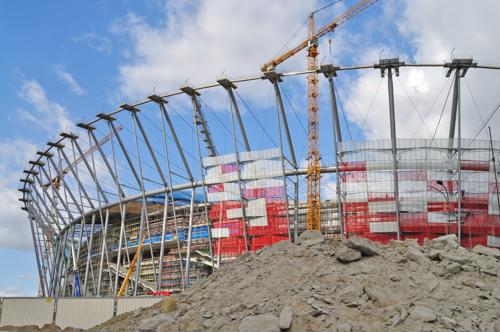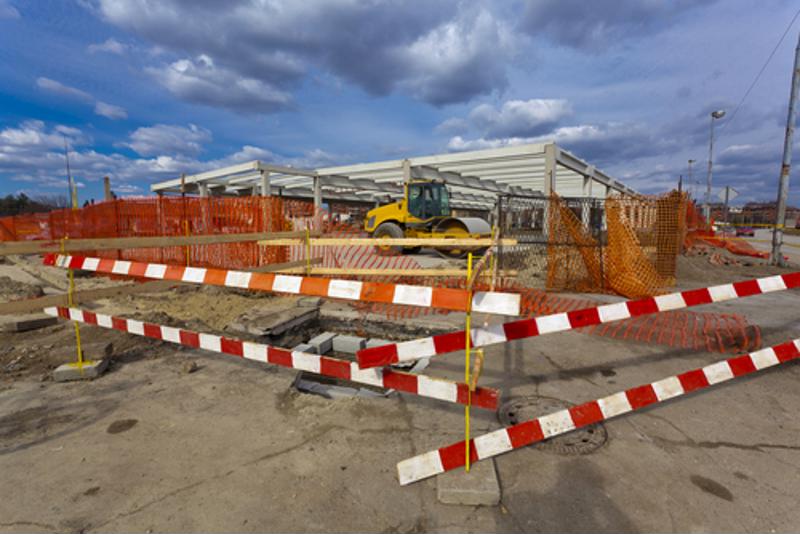
IoT makes considerable inroads in the U.S. construction industry
By Max BurkhalterMay 1, 2019
After years of hesitation, the construction industry is finally embracing internet of things technologies to improve the efficiency, safety and profitability of their operations. Recent advances in equipment sensors and other embedded devices have enabled high-speed data transmission at a lower cost, removing some of the financial barriers that had kept many construction companies from fully adopting IoT solutions.
Over the next five years, the global IoT sensor market is expected to grow at a CAGR of 40%, exceeding $68 Billion by 2024, MarketWatch reported. While the construction industry is only a minor driver of the market's expansion, the increased demand for real-time monitoring capabilities in commercial building projects may push developers to create smaller, smarter and cheaper sensors. Companies looking to refine their performing systems and decrease their downtime are actively leveraging machine-to-machine communications and telematics applications to track operating conditions, productivity, waste and employee safety, but long-term integration will require careful attention to specific use cases.
How does IoT fit into construction environments?
First, it's important to note that equipment manufacturers have played an essential role in fueling IoT adoption in the construction industry. Almost every modern construction vehicle and piece of heavy-duty machinery contains some form of embedded sensor technology, which allows contractors to collect data on fuel consumption, idle time, utilization and location. This information helps equipment owners streamline their operations, predict maintenance needs, and prevent theft and misuse, per ForConstructionPros.com. More advanced systems are capable of measuring a wider range of operational parameters, such as the engine load, fluid temperatures and line pressure.

Generally speaking, IoT technologies provide construction companies with three broad categories of operational benefits: Increased efficiency, improved safety and reduced costs. Of course, these advantages are inexorably linked. For example, fewer workplace accidents often translate to lower insurance premiums, while elevated productivity may help to curtail costly overtime hours. To get an idea for how IoT is transforming the construction industry, let's take a closer look at some concrete examples.
Increased efficiency
Both small- and large-scale building projects involve complex processes that must be effectively managed to meet completion deadlines and budgetary limitations, but it can be hard to predict where issues will arise. According to a study from KPMG, just 25% of construction projects came within 10% of their original deadlines between 2012 and 2015. What's more, McKinsey and Company found that large projects typically take 20% longer than their expected timeframe and often exceed their budget by up to 80%. These production delays can cause significant problems for all stakeholders involved, from contractors to real estate investors, demonstrating the value of IoT-driven productivity gains.
One of the challenging areas for construction is concreting, as foremen must accurately schedule casting and track the maturity of their materials to ensure they meet quality benchmarks and avoid waste, per IoT For All. However, new IoT temperature probes can monitor concrete maturity in real-time, allowing production teams to coordinate their workflows and meet tight deadlines. They also enable accurate modeling of job site conditions, minimizing the impact of environmental variables like humidity and fluctuating weather.
Improved safety
The construction industry is one of the most dangerous employment sectors in the U.S., accounting for 1 in 5 occupational deaths in 2017, according to the Occupational Safety and Health Administration. A vast majority of these fatalities were caused by just four workplace hazards: falls, electrocution, caught-in/between and being struck by an object. While IoT devices will not be able to prevent every injury and death, they can help safety experts generate data-driven insights that may enhance risk mitigation.
The growing popularity of wearable IoT highlights the practicality of employee monitoring, as it has been shown to accelerate injury response times and streamline accident reporting processes, per ZDNet. The data collected from IoT sensors in employee uniforms may lead to more proactive occupational health and safety initiatives, which would benefit workers and employers in the commercial construction space.
Reduced costs
Taking full advantage of IoT applications can be costly, which is why many construction companies try to balance their technology expenses with the amount of capital they expect to save. This involves the comprehensive evaluation of any anticipated productivity gains and material cost savings, along with the calculation of both direct and indirect expenses. Despite the overhead, more than three-quarters of contractors believe IoT will help them control occupational risks, while about half expect it will mitigate property damage and construction defects, according to a 2019 survey from Dodge Data & Analytics.
IoT technologies are also fostering greater collaboration between construction companies and insurance providers, as both parties have a vested interest in improving occupational safety and reducing compensation claims, Digital Journal reported. As new technologies continue to transform the construction industry, contractors will increasingly rely on risk management solutions that accurately model real-world environments.
Perle offers powerful connectivity tools that can help contractors improve operational efficiency and workplace safety, such as our industrial-grade ethernet switches and robust console servers. Read some of our customer stories to learn more.



